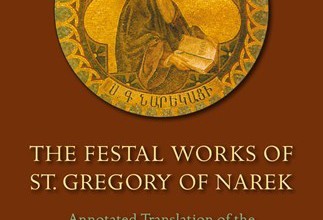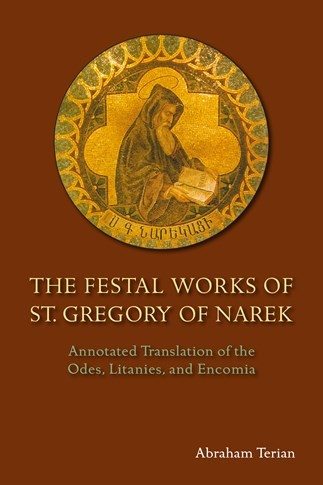Uncovering Unknown Masterpieces of Armenia’s First Great Mystic Poet

A thousand years ago, a monk in a distant monastery in the Western Armenian province of Reshdunik picked up a reed pen and began etching out what would later become known as the first great piece of Armenian mystic and liturgical poetry.
Krikor Naregatsi (Gregory of Nareg), who spent his entire life in the monastery, died at the relatively young age of 50, but what he left behind has outlived his time: As long as one Armenian heart beats anywhere in this world, his inspired odes and lamentations will continue to find an echo there.
His writings, described by critics as “literary masterpieces in both lyrical verse and narrative,” have only been known in their original golden Grabar (Classical Armenian) to a select cadre of Armenian scholars, an oversight now boldly atoned for by Dr. Abraham Terian, the eminent expert on Medieval Armenian literature.
Terian’s “groundbreaking” and “magnificent” new book, The Festal Works of St. Gregory of Narek (461 pages, the Liturgical Press, Minnesota, 2016) is the first translation (embellished with 54 pages of introduction and an array of explanatory notes) in any language of the surviving corpus of Naregatsi’s festal works. Terian’s mellifluous English and his mastery of Grapar have made this onerous task a joy and a celebration.
Like other Jerusalem Armenians, Terian’s first encounter with Naregatsi occurred at a tender young age, when at the graduation ceremony of primary students at the Armenian parish school he was handed a copy of a Naregatsi prayer book, the “Aghotamatyan,” as a parting gift. It was meant to be a guide and inspiration for the future.
The tradition continues to this day. I’ve kept my own copy for half a century, and remember a line from one of Naregatsi’s most poignant odes, his magnificat of God: “The darkness of the night cannot eclipse the glory and grandeur of your dominion” (my translation).
With his new book Terian, who has won plaudits from various parts of the world—the latest his acceptance as a fellow academician (as an “Orientalist”) by the Ambrosian Academy of Milan—escorts us into a new dimension of spirituality.
His skill in penetrating what Harvard professor James Russell calls the “extremely sophisticated content and difficult language” of Nareg is particularly remarkable.
“His work is more than a monument of meticulous scholarship,” Russell said. “The work is of such a high standard that it is unlikely to be equaled, much less superseded.”
Naregatsi, a 10th-century Armenian poet, mystical philosopher, theologian, and saint of the Armenian Church, was born into a family of writers. He is considered “Armenia’s first great poet.” In token of his unique achievements, Pope Francis declared him a Doctor of the Universal Church in February last year.
“Saint Gregory knew how to express the sentiments of your people more than anyone,” Pope Francis said in a statement addressed to the Armenian Church. “He gave voice to the cry, which became a prayer of a sinful and sorrowful humanity, oppressed by the anguish of its powerlessness, but illuminated by the splendor of God’s love and open to the hope of his salvific intervention, which is capable of transforming all things.”
Commenting on the Pope’s momentous ecumenical move, Terian recalls that “while Armenians were about to canonize their martyred saints of a hundred years ago, the papal declaration reminded them of one of their saints who died a thousand years ago. This should imply that identity and perpetuity for Armenians lies not only in the collective remembrance of their recent past, however tragic, but also in their centuries-old Christian heritage.”
The significance of Terian’s latest oeuvre, a timely token of that heritage, cannot be understated. Were it not for his polished and inspired translation, the anthology of Naregatsi’s unparalleled liturgical masterpieces would have otherwise been lost to us.
As UCLA Professor of Armenian Studies S. Peter Cowe notes, Terian “has placed us in his debt again by transmitting these pearls of medieval Armenian poetry from the preserve of a small group of experts into the public domain through his accurate idiomatic translation and helpful notes.”
Theo Maarten van Lint, Calouste Gulbenkian Professor of Armenian Studies at Oxford University, for whom Terian’s book is “magnificent, groundbreaking” goes so far as to describe Naregatsi’s work as “an act of Divine grace.”
“I go up to Jerusalem
“To that city built by God
“To that beautifully built temple…” cries out Naregatsi in one of the odes translated by Terian, giving voice to a universal yearning for the ethereal.
More than any other geographical or metaphorical entity, Jerusalem remains forever the symbol of that longing.
For Terian, and all Armenians who grew up in the Old City, trod its cobblestoned alleys, and drank its waters, Jerusalem is more than a place in the heart.
It is where life begins, where humanity is born and rejuvenated, physically and spiritually.
Source: Armenian Weekly Mid-West

